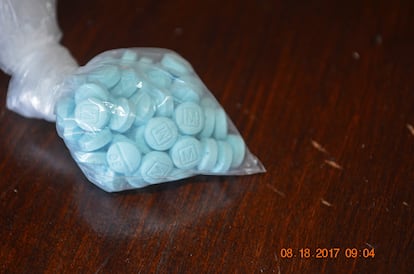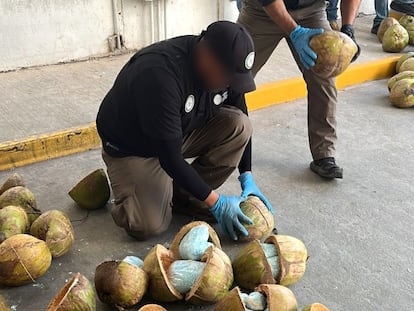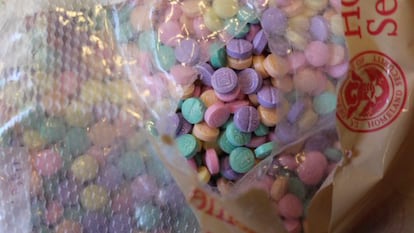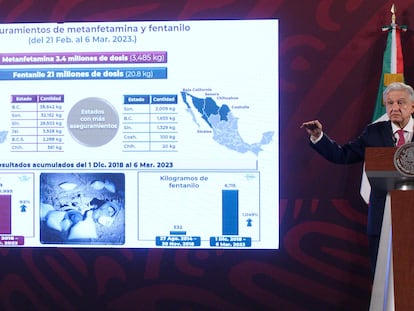Myths and truths about fentanyl, the drug straining US-Mexico relations
Experts in pharmacology, anthropology and medicine explain what it is, its effects, how it is consumed, the torture of withdrawal and the risks of overdosing


Everyone is talking about fentanyl. For some time now, the opioid has dominated the public conversation — or, at least, the political agenda. The powerful drug is wreaking havoc in the United States and straining diplomatic relations with Mexico (accused of being one of the largest producers) and with China, in the middle of a new Cold War that seems to intensify by the week. Many things are being said about the drug, some true, some not so much. EL PAÍS brought together three experts who have studied fentanyl from the point of view of pharmacology, anthropology and medicine, including the medical and social implications of addiction, the torture of withdrawal syndrome, the ease of buying doses in streets that are flooded by the law of supply and demand, the high probability of an overdose, and the criminalization of consumers.
Fentanyl, a drug 50 times more powerful than heroin?
“Take the best orgasm you’ve ever had, multiply it by 1,000 and you’re still nowhere near it,” proclaimed Ewan McGregor in Trainspotting (1996) as he recounted the misadventures of a group of heroin addicts in a gray and futureless Edinburgh. That sentence has found an echo almost three decades later in a statement repeated over and over again: fentanyl is 50 times more powerful than heroin. Does this mean that its effect is 50 times greater than that of the drug that devastated entire generations in the 1980s and 1990s? The answer is no: “When we say that fentanyl is 50 times more powerful than heroin, we are saying that you need 50 times less of it. It has the same effect as heroin in terms of euphoria, but with 50 times less amount,” explains the pharmacologist Silvia Cruz, who has written about the subject.
“In pharmacology, potency and efficacy are often confused. Efficacy is the ability to achieve something: how much pain a pain reliever can take away. Potency is how much you need to get it done,” she says. In the case of fentanyl, you need 50 times less amount to produce an effect similar to that of heroin, and therein lies one of its main risks: “It’s very easy, while seeking a euphoria-producing dose, to reach a lethal dose.” In numbers: “You need 10 milligrams of morphine to take away the most intense pain in a 70-kilogram [154lb] person, and only 0.1 milligrams of fentanyl. I figure that with a kilo of fentanyl you have enough for half a million lethal doses,” adds Cruz.
Fernando Montero, a medical anthropologist with more than 10 years of experience researching drug users and dealers, adds some nuance: “Fentanyl is said to be more powerful than heroin, but that is a very poor way of describing it. Fentanyl is a weaker substance than heroin: it binds to the body’s opioid receptors more easily and more strongly, it causes greater central nervous system depression, but it is also metabolized faster, so that the effect lasts much less time, and, even more importantly, the withdrawal symptoms appear sooner.” For this reason, he explains, it is often mixed with other substances such as xylazine, a sedative for horses, to prolong the effect.

The effects on the body
Experts describe the effect of fentanyl as a kind of peaceful, relaxed euphoria. “Opioids give you a feeling of well-being, any pain you have is taken away, it’s a sense of floating without pain, isolated from the external environment,” explains Guillermo Domínguez, an intensive care physician and anesthesiologist at Spain’s National Institute of Nutrition. “The most widely used opioid for anesthesia at the global level is fentanyl,” says this doctor. “That is why its use as a legal medicine should not be criminalized.”
“Heroin has always been described as a substance that embraces you completely, as a full-body, very pleasurable experience. When it is pure, the effect can last 10 to 12 hours. The experience of fentanyl is more focused in the neck and the face. A similar effect is achieved but for a very short time. The initial rush of fentanyl, the euphoria of the first 10, 15, 30 seconds, is stronger than that of heroin, but after that, the rest of the experience is a lot shorter,” he adds.
How it is consumed
Fentanyl can be injected, inhaled, smoked or swallowed in pills, although if there is one thing about addiction, it is that the forms of consumption are creative and constantly adapting to the environment. “On the streets, you can find everything from powder to things that look like sugar cubes, blue pills [called M30] and colored pills, and surely other presentations are already coming out because it’s like any market, there’s always more supply,” says Cruz. Powder and pills, according to this expert, are the most common way to consume fentanyl. The pills are crushed, then the powder is burned on aluminum foil the same way as heroin, and the smoke is inhaled.
Montero, on the contrary, assures that the most widespread option to consume fentanyl is through injection, as a legacy of heroin. For decades, there were two monopolies in the United States: in the east, white-powder heroin from Colombia; in the west, solid, black heroin from Mexico. “In the east, fentanyl entered undetected as it resembled heroin. In the west you couldn’t inhale it because what was sold was a black gum, so people injected it. You can smoke it, but it is not considered an efficient way to consume it, as you lose a lot of the substance. Injection among the people I work with, who live on the streets, is by far the most common way of consuming [fentanyl}.”

Addiction and withdrawal
The euphoria of the first dose dissipates with the second dose, and even more so the third time around. The body quickly develops tolerance to the drug, which means that to in order to find the same peace of mind as the first time, it has to be consumed more frequently or in a greater dosage. “There comes a time when users are increasing the doses so much that there is no time to adjust them and they become lethal when they build up,” notes Domínguez. “You develop tolerance to the euphoric and analgesic effects, but not to the respiratory depression that fentanyl causes. Looking for the euphoric effect, you reach the lethal dose.”
And when not enough doses are achieved to maintain the effect, withdrawal symptoms quickly appear. “It’s a torture experience that you wouldn’t wish on your worst enemy,” says Montero. Fentanyl inhibits cells. When the inhibitor wears off, the cells become hyperexcited. “Anything causes those neurons to fire throughout the nervous system.” The first thing that appears is hyperalgesia, the opposite of an analgesic effect. “It hurts where it shouldn’t hurt,” Cruz explains. It starts like a flu, the body produces tears and mucus, joint pain, diarrhea, vomiting, chills, intestinal cramps, contractions, uncontrollable movements in the legs... “It reaches its maximum after 72 hours, and it feels very bad for a week. If they can get their hands on the opioid they will, because to them, it is like being sick and getting cured.”
Overdose
Around 70,000 people died of fentanyl overdoses in 2021 alone, the equivalent of nearly 200 people a day and an increase of 94% compared to two years earlier, according to a study by the US Centers for Disease Control and Prevention (CDC). Taking a lethal overdose, experts explain, is easy. “Unlike heroin and morphine, fentanyl has an enormous capacity due to its chemical structure to cross biological barriers and quickly reach the central nervous system. It arrives so quickly that a person can die with the syringe still in place,” warns Cruz.
Fentanyl acts as a central nervous system depressant, inhibiting the neurons that control breathing, the ones that make you breathe in and out automatically. That is to say: the body forgets to breathe and you die. Montero, however, provides another vision: “There are a million people out there using fentanyl, which means that it is not the poison that everyone believes it to be: it is possible to have an addiction and not die, and the vast majority of people are in that situation.” However, overdoses with fentanyl are more likely than with heroin, notes the medical anthropologist. The substance is cut and mixed with other drugs, and a mistake that delivers a higher dose of fentanyl — something that can easily happen, because the percentage of the opioid that can safely be consumed is tiny — can be lethal. In samples studied in the US, it was discovered that many of the doses contained 2-10% fentanyl and the rest was xylazine, the horse sedative.

“The market is not regulated and there are certain sellers who will make a mistake and put too much fentanyl in the substance. In Philadelphia, where there is a fairly structured market, we see that this does not happen a lot. The wholesalers know what they are doing because they do not want to kill their consumers, as they depend on them to keep selling, in addition to the fact that if many people die it will attract the police. So there is quality control, but the mechanisms they have are very rudimentary.”
The main antidote for a fentanyl overdose is naloxone, which binds to the same sites as fentanyl, but because it has a higher affinity with the body, it displaces the opioid. It does not cause addiction or generate euphoria, but it does cause withdrawal symptoms, warns Cruz. “It has nothing to do with methadone, which makes people feel good and keeps neurons quiet. The ideal situation is to have naloxone for overdoses and methadone so that users don’t go through the detox process on their own, suffering a lot.”
Sale
Montero lived for years on a street in the Kensington neighborhood of Philadelphia, where his neighbors were drug dealers. “The street-level seller has no role in making the substance, which is packaged three hierarchical levels above him in the supply chain. There are wholesalers who live in the suburbs: these people are mixing [the drug] and do not receive any attention from the police or public health officials or journalists. The U.S. is so obsessed with punitive measures that they blame the street seller without knowing how the market works; they simply assume that the dealer is an evil and criminal guy that wants to poison his consumers.”
Sign up for our weekly newsletter to get more English-language news coverage from EL PAÍS USA Edition
Tu suscripción se está usando en otro dispositivo
¿Quieres añadir otro usuario a tu suscripción?
Si continúas leyendo en este dispositivo, no se podrá leer en el otro.
FlechaTu suscripción se está usando en otro dispositivo y solo puedes acceder a EL PAÍS desde un dispositivo a la vez.
Si quieres compartir tu cuenta, cambia tu suscripción a la modalidad Premium, así podrás añadir otro usuario. Cada uno accederá con su propia cuenta de email, lo que os permitirá personalizar vuestra experiencia en EL PAÍS.
¿Tienes una suscripción de empresa? Accede aquí para contratar más cuentas.
En el caso de no saber quién está usando tu cuenta, te recomendamos cambiar tu contraseña aquí.
Si decides continuar compartiendo tu cuenta, este mensaje se mostrará en tu dispositivo y en el de la otra persona que está usando tu cuenta de forma indefinida, afectando a tu experiencia de lectura. Puedes consultar aquí los términos y condiciones de la suscripción digital.
More information
Archived In
Últimas noticias
Most viewed
- Reinhard Genzel, Nobel laureate in physics: ‘One-minute videos will never give you the truth’
- Oona Chaplin: ‘I told James Cameron that I was living in a treehouse and starting a permaculture project with a friend’
- Pablo Escobar’s hippos: A serious environmental problem, 40 years on
- Why we lost the habit of sleeping in two segments and how that changed our sense of time
- Chevy Chase, the beloved comedian who was a monster off camera: ‘Not everyone hated him, just the people who’ve worked with him’










































